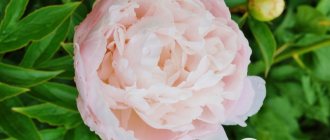Description and photo of white peonies
Today there are a large number of varieties of white peonies known. Based on the color of the bud they are divided into several categories:
- with snow-white flowers;
- with cream buds;
- with red splashes;
- with a yellow core;
- with a greenish tint;
- with pink color in the center.
There is also a classification according to the shape of the buds:
- Terry, with a large number of petals surrounding the middle in 2 - 3 levels. The stamens look similar to petals, but there are varieties with traditional stamens.
- Non-double, consisting of 6-10 petals arranged in two rows. In the center are the pistil and stamens.
- Semi-double have at least five petals. There are non-standard and traditional stamens in the center.
- Japanese or transitional. They are distinguished by their stamens, which are predominantly yellow in color. This species is considered a middle ground between the double and non-double types. The classification is given based on the place of selection of such varieties.
- Anemones have long petals at the bottom and short ones at the top. Outwardly they resemble a ball. Stamens in the form of petals.
This is the main classification of white peonies. The height of these plants does not exceed 100 cm. Most known varieties of peonies are perennial, but there are those that live only one year. The stem is quite strong, so the flower survives strong winds well. The root system grows quickly.
Features of planting and care
Beautiful white peonies do not have difficult growing requirements. To cultivate them on the site, it is enough to follow the basic rules:
- It is best to plant a perennial in the fall in September; it will have time to take root safely. Choose a place for the plant that is well-lit, but sheltered from the wind and with light shade; the soil should be quite loose and not swampy.
- A few weeks before planting, dig a shallow hole twice the size of the root system of the seedling and fill it halfway with a mixture of sand, humus, peat and garden soil. Superphosphate, iron sulfate and wood ash are also added to the hole.
- The peony is lowered into the hole, sprinkled with soil mixture to the end and trampled around, and then watered generously and mulched with peat.
For further care, you need to water the peony only when the soil is very dry; waterlogging harms it. Fertilizers for good flowering are applied three times a season - in the spring the perennial is fed with nitrogen, and before and after flowering with phosphorus and potassium.
Advice! In the first 2 years, fertilizing can be skipped if minerals were added to the soil during planting.
With the onset of autumn in October, the stems of white peony are cut almost flush with the ground, leaving no more than 4 cm. Most varieties of the crop overwinter well without shelter, but usually the flowerbed is covered with humus or peat - organic matter plays the role of autumn feeding and insulates the roots. In cold regions, the crop can be additionally covered with spruce branches.
Popular varieties
Despite the wide variety of varieties and species, only a few of them have gained popularity in Russia. It is worth taking a closer look at what peonies are grown in garden plots in the Russian Federation:
- Rose Marie Lins. The cream-colored buds look rich. There are small pink spots in the center. The petals are soft, form a strong bud, the size of which reaches 25 cm. There is a citrus aroma. The bush itself grows up to 90 cm in height.
- Shirley Temple. A double bud, up to 20 cm in size. The petals initially have a slightly pinkish tint, but then become completely white. The height of the bush is no more than 90 cm. The foliage is lush and persists until autumn.
- White Swan. The buds are spherical, terry type. The inner petals are narrower than the outer ones. The flowers themselves are quite dense. Powerful bush up to 80 cm high. Used for cutting and in landscape design.
- Festiva Maxima. The buds are terry type, up to 20 cm in diameter, there are pink inclusions in the center, the petals themselves are snow-white. Flowering period from May to July.
In Russia, white peonies are found in any climate zone. Because the flowers are unpretentious and adapt well to any weather conditions.
Tree-like white peonies
In China and Japan, white symbolizes purity and solemnity. Breeders worked for a long time to obtain tree peony flowers of a color close to white. However, pink or red sparkles may be present in the middle of the flower, and the tint of the petals may be yellowish.
Snow Tower/Xue Ta, China
Peony Snow Tower grows up to 150 cm in height and blooms at the age of 6 years. The flowers are double, similar to roses. The color is white, pink closer to the middle. The diameter of the open bud is more than 15 cm.
White Jade (China)
Large-flowered peony, with huge, wide-open semi-double flowers. The petals are snow-white, with yellow stamens standing out brightly against their background. The height of the bush is from 1.5 to 2 m. Cut flowers last a long time, spreading a bright aroma.
White Phoenix (Feng Dan Bai/White Phoenix, China)
Large simple flowers, white with a pink tint, bloom earlier than other peonies.
Maria (Russia)
A loose tall bush, reaching 140 cm. The flowers are large, up to 19 cm in diameter. The shape is semi-double, the petals are white, slightly wavy along the edge. In the center, a faint pink coloration of the petals is noticeable.
Silk veil (Gui Fu Ren, China)
Compact plant, 120-130 cm in height. The flowers are large, with wavy edges of the petals. The color is white, with burgundy sparkles in the middle. The variety is winter-hardy and is successfully grown in the Moscow region.
Flowering time
White peonies have different flowering periods. Thanks to this, several varieties can be grown on the site. This means that when some buds fade, new ones will bloom. As a result, you can enjoy the sight of these beautiful plants all summer long.
There is a classification based on the time of bud blooming, which usually occurs in the first month of summer:
- spring, bloom until June 5;
- early, bloom from 5 to 10;
- mid-early, blooming from June 10 to June 15;
- average: from 15 to 20;
- medium-late, the buds of which bloom by June 20–25;
- late ones, begin to bloom from 25 to 30;
- very late, bloom after June 30.
Thus, with the right choice of varieties, you can achieve flowering throughout the summer.
Important. The buds bloom in 2 – 3 weeks. Therefore, it is necessary to select varieties based on the duration of flowering.
Historical varieties
The most famous, perhaps, are the legendary vintage ' Sarah ' (1906) and ' Festiva ' (1851).
These varieties are many years old, but they are still beautiful and in demand. You can read more about them in the publication Peonies that can surprise: the most memorable varieties and types. The incomparable 'Sarah Bernhardt' is an extraordinary blackcurrant ice cream color. Photo by the author These are profusely and long-blooming peonies, resistant to disease (otherwise they would not live so many years!), and good for cutting. Using the terminology of international competitions, they undoubtedly deserve the Grand Prix.
'Festiva Maxima' is a well-recognized and beloved peony. The flower has characteristic crimson strokes. Photo by the author
If you want to expand the color palette of peonies in your garden, among the ancient ones, the French dark burgundy variety of medium flowering period ' Marechal Mac Mahon' ('Marshal Mac Mahon') and ' Felix Crousse' ('Felix Cruss') deserve attention, abundantly and long-lasting blooming with large violet-red flowers with silvery tips of the petals. 'Felix Crousse' blooms profusely, all the flowers bloom together and do not fall off for a long time. Photo by the author Magnificent fragrant varieties:
- 'Madame de Verneville' ('Madame de Verneville') - white-pink, has a rose scent;
- 'Duchesse de Nemours' ('Duchesse de Nemours') - early blooming, with the scent of lily of the valley, white flower with yellow highlight.
Their flowering reminds of childhood and grandmother's garden, where they spent the summer.
These varieties are still alive and quite often found on sale. On the left is the peony 'Madame de Verneville', on the right is 'Duchesse de Nemours'. Photo by the author We can recommend a few more beautiful French peonies.
- ' Albert Crousse' ('Albert Crousse', 1893) - pink-shaped, warm pink tone, decorates the garden already at the end of flowering of the majority of varieties;
- ' Monsieur Jules Elie' ('Monsieur Jules Elie', 1888) - pink-lilac. He and 'Albert Crusse' were repeatedly recognized as show leaders at exhibitions;
- 'Reine Hortense' ('Reine Hortense', 1857) is an old French peony, double, rose-shaped, soft pink in color with a rich center. In 2022, it won the People's Choice Award.
Peony 'Monsieur Jules Elie' has a pink-lilac color. Among the oldest varieties at exhibitions you can see incomparable peonies, which, as it turns out, are not afraid of age. In particular, the Lemoine variety 'Edulis Superba' ('Edulis Superba', 1824).
Terry, crown-shaped, pink-lilac, unusually fragrant, like all “French”. It is often found in gardens and markets, but we do not even suspect what a treasure it is, considering it just an ordinary peony, which we are used to. In our market, which unites large online stores, you can choose the varieties of peonies discussed above. Take a look at the selection of Amazing peonies of French selection.
Herbaceous peony for patio MADRID, 1 pc. 603 RUR
seedspost.ru
Herbaceous peony Duchess de Nemours 519 RUR
Agrofirm Search
Peony milky-flowering Sarah Bernhardt (V3l.) 738 RUR
Agrofirm Search
Herbaceous peony Felix Krauss 429 RUR
Agrofirm Search
Features of cultivation
Each plant requires special attention to itself. Peonies are no exception, despite the fact that they are practically unpretentious. It is worth considering in more detail how to properly care for these flowers, so that the buds are large and the plant itself remains healthy.
Landing
These flowers should be planted in the fall. To do this, you need to perform a number of actions:
- Dig a hole 60x60x60. If there are several roots, then the distance between the holes should be at least 100 cm.
- Place a drainage layer on the bottom. It is advisable to use expanded clay.
- Add a layer of soil.
- Carefully lay the root so that the top bud is at a depth of 3–4 cm.
- Cover the rhizome with soil and lightly water it.
If the peony root appears in the spring, it is recommended to plant it in a pot and place it in a cool and dark place so that it does not germinate.
Important. The soil in the pot should always be moist. It is recommended to place ice or snow on it. By gradually melting, it will not allow the earth to dry out. At the end of August you will need to transplant into open ground.
When is the best time to plant?
Planting should be done in the fall, but before that the soil must be disinfected. In the Southern Federal District, you can leave the root without additional protection, since winters there are mild.
However, in other regions it is necessary to perform certain actions to protect the plant from the cold:
- put peat mulch on the hole;
- cover everything so that the wind does not scatter the mulch and the snow does not wash it away.
Important. If there is a suspicion that the winter will become especially cold or the gardener lives in the northern part of Russia, then the root can be planted in the spring. But at the same time it is placed in a pot of soil. After 2 - 3 weeks, when the peony gets used to the new conditions, it is necessary to remove it from the pot and leave it in open ground.
The best and most beautiful varieties of peonies with photos and names, as well as a catalog of ITO hybrids with a description
Amazing color, aroma spreading throughout the garden, lush buds - these are the most suitable characteristics of peonies.
Over time, a large number of different varieties were invented, which were subsequently supplemented by hybrid variants.
When planning planting, it is recommended to study in more detail their various types and varieties with photos and names.
This will make it easier to arrange flowering at a certain period of time and to dilute the garden ensemble with bright contrasting colors.
How to care for a flower?
Peonies do not require special care, but you should not forget about them. They require minimal attention and proper planting location. These flowers love light, but in nature they also grow in shady areas. In this case, their main forces go into the foliage, and the buds turn out to be small.
Watering
Peonies need to be watered as the soil dries out. It is recommended to use no more than 20 - 30 liters of water. In order for it to reach the depth where the root system is located. Here are some rules for watering white peonies:
- After planting the plant, you must carefully fill the hole with water.
- When the soil dries out, water it moderately.
- It is necessary to pour water under the root so that it does not get on the leaves of the plant.
- During the period of active flowering, watering should be made more abundant.
- A couple of weeks before preparing the peony for winter, watering the plant must be stopped.
Important. In strong sunshine, it is forbidden to water any flowers, as there is a risk of them getting burned. It is recommended to do this on cloudy days or in the evening.
Top dressing
Gardeners alternately use organic and mineral fertilizers. The first ones can be added dry.
There are several periods in the life of a peony when feeding is necessary:
- spring: May 15 – 20;
- two weeks after adding the first portion of fertilizer;
- during intensive growth.
Important. It is necessary to fertilize in accordance with the instructions. There are many different fertilizers. Potassium is needed during active growth. Phosphorus and superphosphates are required during the flowering period. When using organic fertilizers, care must be taken to avoid ammonia damaging the peony roots. Excessive amounts of which in the soil negatively affect the development of the plant.
At the end of flowering, adding fertilizers to the soil is pointless. If minerals dissolve in water, then they must be poured at the root.
Caring for white varieties
Peonies require careful care. This is the only way to achieve beautiful flowering of the bush.
Watering and fertilizing
Orange roses - description of the best varieties
Peonies must be watered regularly, especially before flowering, in the first half of June. Watering is also required during bud formation and root growth. This time refers to July and September.
Important! Feeding is carried out for 3-4 years after direct planting.
From the third year after planting, it is necessary to feed the plant. In early spring, feed urea under the bush. The second feeding is carried out during the formation of buds, and then at the beginning of flowering. Fertilize with nitrophoska - 1 tsp. on the bush. The fourth time is fed 2 weeks after flowering. Apply superphosphate and ash 1 tbsp. spoon.
Regular watering is important
Mulching and loosening
Peonies prefer loose soil. However, loosening must be done carefully. At a distance of 10 cm from the bush, loosening can be deep. In spring it is worth mulching with a small amount of rotted manure.
Preventative treatment
The treatment is carried out two or three times. The interval between treatments should be 10-12 days. The procedure is based on spraying with a fungicide solution.
Pests and diseases
Peonies have high immunity, but from time to time they are still susceptible to diseases such as:
- Tobacco rattle virus or peony ringspot virus. Small rings or stripes of yellow or green appear between the veins on the leaves. It is recommended to remove affected plants and burn them. However, the severity of the disease depends on the variety. Some varieties are resistant to this virus.
- Gray rot manifests itself in the presence of gray mucus on the leaves of peonies, which gradually kills the plant. Young shoots are most often affected. If rot appears during the bud opening period, then large flowers that have already opened take on a brown tint. And the buds themselves turn black. Rot appears due to improper care and heavy rains. It is necessary to treat the plant with fungicides to get rid of the problem.
- Rust is characterized by the presence of brown spots on peony leaves. After a while they curl and dry out. To combat it, fungicides such as “Topaz” and “Vectra” are used 2 – 3 times in 10 days.
- Root rot occurs due to the influence of fungi. The root becomes covered with mucus and begins to rot. As a result, the stem darkens and the plant withers. You need to dig up the flower, cut off the damaged areas and clean them of mushrooms. The soil should be replaced and the affected one disinfected.
In addition, gardeners growing white peonies have to deal with the following pests:
- bronze beetles;
- root-knot nematodes;
- ants;
- aphid;
- spider mite
A solution of soapy water or industrial poisons are used against these insects.
General description of peonies
Peonies (lat. Paeónia) belong to the peony family (Paeoniaceae) and are perennial plants that have large rhizomes that penetrate deep into the soil. The height of the bush can reach 0.75-110 cm. Decorative foliage is green with a purple tint. Foliage color changes throughout the growing season.
The flowers are single, large - their diameter is 15-20 cm. The shape of the flower depends on the variety. It can be terry, pink or spherical. The fruits are complex, multi-leafed, each containing several black seeds.
The frost and drought resistance of the flower allows it to be grown in different climatic conditions. However, it feels more comfortable in well-lit places, and it can grow in the same place for 10-12 years.
Peonies begin to bloom at the end of May, and some varieties bloom later - in July and even in August. The duration of flowering, depending on the variety, lasts from 1 to 3 weeks. Reproduction is by seed and vegetative.
Reproduction methods
There are two ways to propagate peonies. However, not one of them allows flowering to occur within 3 to 5 years. These include:
- Use of seeds. It is necessary to collect them yourself and treat them from possible viruses and bacteria. After drying, they are placed in a paper bag. In autumn they are sprouted and planted in a pot. In spring, transplant into open ground.
- Dividing the bush. In this case, cut the root into two parts. It is important that both of them have buds. The cut is treated with activated carbon, after which the roots are placed in the ground and watered moderately.
Important. Damaged roots are restored within 1 – 2 years. Therefore, there is a possibility of either a complete absence of flowering, or it will be minimal. But after 3 – 5 years the plant will delight with large buds.
Thus, white peonies are often used by modern gardeners to decorate summer cottages. The flower is unpretentious, so it can be grown throughout Russia without any problems.
Growing a flower, how to plant it in open ground
When planting a peony, it is important to follow the rules that will allow you to grow a beautiful flower.
Planting with root cuttings
Hydrangea serrata - description of the best varieties, planting and care
A root stalk is a small part of the rhizome that has a growth bud and a root. Flower growers often resort to this method of planting peonies in open ground.
What time does boarding take place?
The pieces are harvested after the buds have ripened, but even before small white roots form. Cuttings are carried out in July-August.
Selecting a location
The planting site should be sunny and protected from drafts. However, there must be a normal air supply.
Important! If you choose the wrong planting location, the peonies may die.
How to prepare the soil and flower for planting
The soil should have neutral or slightly alkaline acidity. It should also be light and fertile. Before planting, the rhizome is soaked in a solution of potassium permanganate for a couple of hours.
Proper care is important for peony
Boarding procedure
Step by step planting process:
- Dig up the rhizome and clean it.
- Divide the cuttings so that each of them has a root and a growth bud.
- The cuttings are soaked in a solution of potassium permanganate. They are then rolled in charcoal and left overnight.
- Plant pieces of rhizome at a distance of 15-20 cm from each other.
Proper planting of peonies will ensure abundant and beautiful flowering.
Planting by seeds
The collected seeds must be immediately planted in the garden bed. The seeds are deepened by 5 cm. In order for the seeds to germinate faster, it is necessary to be exposed to variable temperatures throughout the day. During the day 25-30 ℃ above zero. At night +15 ℃.
The most beautiful types of peonies with photos
Often the most common time for this type of plant to bloom is summer.
Having discovered several beautiful, lush peony bushes on your site, your mood instantly improves. Such flowers harmoniously complement the dacha, making it a real ball of colors.
To ensure that growing peonies brings only positive emotions, we offer the names of the most beautiful species that are popular today among landscape design of flower beds.
Consider:
- August Dessert. At first glance, it may seem that this is not a peony at all, but an attractive, fragrant cake with cream.
The bud looks so elegant, its aroma attracts insects.
The height of the stem reaches 80 centimeters, and the pink petals are beautifully framed in a thin white thread along the edges.
Green Halo. This species is suitable for growing in a flower garden or flower bed.
The light green shade of the petals will bring joy to the most demanding gardeners in terms of appearance. The cactus-like, terry peony reaches a height of 75 centimeters.
Walter Maines. This species belongs to the Japanese class, its elegant dark red buds harmoniously combine with creamy stamens. Maines is considered one of the rare options.
Miss America. One of the representatives of white peonies, the middle of which is filled with yellow stamens.
The variety is considered mid-early, the plant height reaches 75 centimeters.
Mirage. The most fragrant type of peonies has purple buds. The center of the flower is filled with creamy stamens.
Bright, lush flowering is accompanied by a strong jasmine scent. The option is well suited for growing in the park, as a background for flower beds.
After reading a brief description of each of the most beautiful species, you can safely move on to choosing the best variety of 2022 for the garden.
Classification of varieties of tree peonies
Over two thousand years, tree peonies have become even more magnificent, brighter and more elegant. Modern flower growers have about 1000 varieties at their disposal with corollas of different shapes and shades. Most of them are varieties of Chinese origin, the result of the work of breeders:
- northern Central China;
- southeastern provinces of the country;
- coastal areas of the Yangtze River;
- northwestern regions of China.
Based on this extensive group and perennial species, the best varieties of tree peonies from Europe, the USA and Japan were bred. Thanks to the efforts of many enthusiasts, the world collection of peonies has been replenished with specimens with original flowers in lilac, yellow, and green shades.
Tree peony Hu Lan (Hubei blue) - a classic variety from Hubei province
In the gardens you can see spectacular plants with variegated petals and corollas reminiscent of pom-poms, chrysanthemums or lotuses.
When obtaining unique varieties, flower growers of the New and Old Worlds, like their Chinese colleagues, give preference to double tree peonies with the largest, densest corollas. These varieties are incredibly spectacular and are incredibly loved by gardeners. However, there are other peonies.
Japanese tree peony
Breeders from the Land of the Rising Sun, following traditional ideas of beauty, created a whole group of Japanese tree peonies with single and semi-double flowers. These varieties amaze with their elegance, lightness, exquisite shapes and variety of colors.
Pyonomania. Part I. Review of peony varieties
Photo by the author.
More than a century has passed since the first Chinese varieties of peonies were brought to France, Russia, America and Japan. At first, they gained the greatest love and popularity in France, where during the 19th century several generations of talented gardeners and breeders created varieties with fragrant, densely double flowers, which to this day are considered peony classics and are on the list of all modern manufacturing companies. You will probably immediately imagine huge bouquets in vases and old summer cottages where the descendants of these varieties have been thriving for decades. From the creations of the Parisian gardener Lemon Nicholas, the variety “Edulis Superba” (1824) has come down to us, and Auguste Millet in 1851 created the variety “Festiva Maxima”, beloved by many. The development of selection was continued by: Calot from Douie - “Duchesse de Nemours” (“Duchesse de Nemours”, 1856); Cross from Nancy - “M-me de Verneville” (“Madame de Verneville”, 1885). Working with the Cruss collection, Victor Lemoine opens the 20th century with the creation of masterpiece varieties: “Sarah Bernhardt” (“Sarah Bernhardt”, 1906), Solange (“Solange”, 1907), Le Cygne (“Le Cigne”, 1907).
After the First World War, the center of selection moved to the USA. There, based on French varieties, work begins on creating the first interspecific hybrids by crossing intraspecific hybrids of milky-flowered peony with natural species (P. medicinal, P. thin-leaved, P. large-leaved, etc.). This made it possible to expand the color spectrum of peonies to pure red (without purple tones), coral and bright pink flowers, and to move the flowering period to an earlier date. The results of the work of the pioneers of interspecific hybridization A. Saunders - “Athena”, “Ballerina”, “Cytherea”, Othena - “Chocolate Soldier”, “ Red Dandy”, as well as Glasscock – “Red Charm”, “Red Grace”, “Salmon Beauty” are not particularly represented need, because they are world famous. In 1903, the American Peony Society (APS) was formed, which since 1974 has served as an international registrar of new varieties of peonies. Currently, the society’s website contains 267 electronic pages with more than 6,000 registered varieties of herbaceous and tree peonies. The APS Gold Medal, awarded annually, distinguishes the most beautiful and sought-after varieties with stably inherited traits during propagation, disease resistance, excellent bush habit and affordability. In 2018, the variety “Pietertje Vriend Wagenaar” (“Pietertje Vriend Wagenaar”, 1996, Nicholas J. Friend) received the Gold Medal. The same variety was declared Peony of the Year in 2022.
Peonies came to Russia only under Peter the Great and were grown exclusively in the Apothecary gardens of Moscow and St. Petersburg, as well as in monastery gardens. French varieties that appeared in the 19th century became an invariable decoration of rich landowners' estates and country dachas. After the Great Patriotic War, in 1949, in the Main Botanical Garden of the Russian Academy of Sciences in Moscow, work began on breeding their own varieties of peonies. Then the initiative was taken up by Botanical gardens and scientific institutes throughout the country - in Bashkiria, Siberia, Ukraine, and the Baltic states. Thanks to the painstaking work and enthusiasm of specialists deeply devoted to their work, the domestic selection was a success. Extra-class varieties were obtained that are highly decorative, resistant to adverse weather conditions and suitable for cutting. A striking example is the work of N.S. Krasnova: “Arkady Gaidar” (1958), “Varenka” (1957), “Anniversary GBS” (1959); A.A. Sosnovets: “White Sail” (1961), “Memory of Paustovsky” (1960), “Yablochkina” (1960); Z.I. Archer - “Altai News” (1963).
It is impossible not to mention the wonderful varieties created by amateur gardeners, people of professions far from science, who were united by a common passion for peonies. “Olympics-80”, “Russia”, “Moscow”, “Spark of Hope” are the creations of Mikhail Akimov. “Admiral”, “Anatoly Skakodub”, “Sakhalin”, “Svetlana Sedova” - lush, with strong stems of the Anatoly Skakodub variety (USSR, Kazakhstan). “Kuril Islands”, “Mom’s Heart”, “Coolness”, “Svetlana Udintseva” are long-known and beloved varieties of our contemporary Vladimir Dubrov.
When you visit peony exhibitions or choose new interesting varieties from catalogs to replenish your collection, you inevitably become imbued with great respect for the titanic work of breeders. Imagine, in order to get a variety worthy of the attention of the most sophisticated gardener, you must first select parental pairs capable of producing promising offspring. And sometimes just one couple can’t do it. Then, from the hundreds of seedlings obtained, which at best will bloom in 4–5 years, several of the most interesting ones are selected for further observation. After about 3–4 years, having made sure that at least one of them retains its characteristics every year and does not belong to the “find ten differences” category, the seedling is called a variety. Otherwise, they start all over again. At the moment, my personal collection of herbaceous peonies includes about 150 varieties. Compared to the collections of famous and venerable peony growers, it is very small and very young. Many varieties have yet to show themselves in all their glory.
The last two seasons have surprised all gardeners in central Russia with their diametric opposite. The summer of 2017 was cold and rainy - the flowering of peonies was delayed by almost three weeks. But the summer of 2018 pleased with the heat and minimal rainfall - some large-flowered double varieties were much smaller in size (“Lavon”, “Madylone”), the shape of the flower varied from double according to the variety to almost simple (“Vladimir Dubrov”).
Next, I want to share my impressions of those favorite varieties that, despite various weather conditions, showed resistance and stable flowering in my Vladimir region. After all, it is always interesting how a variety bred in America, France or Kazakhstan will demonstrate the declared high decorative qualities, being so far from its homeland.
I'll start with white peonies:
“AE Kundred” (“A.E. Kundred”, A. Kundred, 1951, USA). An old, well-deserved variety. Excellent cut. A snow-white, perfectly formed rose-shaped flower with a diameter of 16 cm. A tall bush (80–90 cm) with strong stems. Blooms later, from June 23–28. Usually, when choosing a variety, you put the aroma characteristic somewhere in second or third place. Strong, pink, with a spicy tartness, the aroma of “A.E Kundred” is just for the first time!
“Capital Dome” (“Capital Dome”, Bigger, 1979, USA). White-cream huge head (diameter 18 cm) with tightly packed, slightly curled petals. The bush is tall (90–100 cm). The stems are strong, but still bend under the weight of the flowers, which from a distance look like large “marshmallows”. It blooms for a long time in the early-mid period, from about June 12–14. Good for cutting.
“Serene Pastel” (“Sirin Pastel”, Klehm, 2000, USA). This variety can be classified as both white and pink peonies. It opens to a soft coral pink, then becomes almost white, maintaining a pink tint in the center. The flowers are large (16–18 cm), beautifully symmetrical, light, airy, from semi-double to double. Despite its fragile appearance, it tolerates both heat and cold with rain. Due to the side buds, it blooms for a very long time (more than 10 days), in the average period, starting from June 15–17.
Life in Pink
“Mrs. Franklin D. Roosevelt” (“Mrs. Franklin D. Roosevelt”, Franklin, 1932, USA). APS Gold Medal in 1948. APS Exhibition Grand Champion (1963, 1984). It’s not without reason that I listed so many regalia. With its highest decorative qualities, the variety deserves a place of honor in every garden. Amazingly built, double, pink-shaped, large (20 cm) flower in half-opening resembles a nymph in shape. The color is very pleasing to the eye - light pink, with a delicate salmon tint on the inside. The bush is strong, 80 cm high, the foliage is always healthy, dark green. Blooms from June 15. If I were asked to choose a bridal bouquet, I would make it only from this variety.
“Lyudmila Askarova” (1987, A. Skakodub, USSR). It should be noted that the domestic selection of peonies is rich in high-quality pink varieties. And “Lyudmila Askarova” is proof of this. The flower is large (18 cm), densely double, pink-lilac. The petals are wavy, tightly arranged in a circle, with a bud characteristic of the variety in the center. The bush is tall and compact. The aroma is light and delicate. It blooms in the mid-late period, from June 18–20. There is an opinion that late varieties of A. Skakodub are developing slowly in our country. But “Lyudmila Askarova,” planted in a high sunny place, already in the third year has 7–8 stems and full flowering.
Red ones are beautiful
“Highlight” (“Highlight”, Auten-Wild, 1952, USA). My mom's favorite peony. Globular, shiny, large (19 cm), very fragrant. The color is memorable, spectacular, dark red beetroot with a chocolate tint. One of the darkest in the group of milky-flowered peonies. Flowering from June 12–15.
“Mackinac Grand” (“Makinac Grand”, DL Reath, 1992, USA). Hybrid. Order of Landscape Merit in 2012. APS Gold Medal in 2013. Peony of the Year in 2014. It is rare that a peony boasts such a bright red color. When “Mackinac Grand” blooms, all eyes are focused only on it. Even photographs of him seem to glow. Add to this strong stems, wavy large petals arranged in several rows around a golden center, early (from June 5) flowering and vigorous growth. The variety 100% deserved all the awards awarded to it.
“Old Faithful” (“Old Faithful”, Glasscock-Falk, 1964, USA). Hybrid. APS Gold Medal in 1997. Order of Landscape Merit in 2009. In the first year after planting, it rather frightened me, opening with an absolutely simple flower without a hint of doubleness. But already in the second year he appeared in all his glory. Dark red velvet petals of a very dense texture formed a double flower with coquettishly peeping golden stamens. The bush's habit can confidently be called a reference one. The stems are very strong with lush green foliage that covers them from bottom to top - just a vase for your own flowers. It is unusually beautiful at the blooming stage, when the curled petals, reminiscent of rose buds, unfold into a huge (20 cm), beautiful flower. Withstood all the hail and downpours of 2017 on its “legs”. It blooms later than many hybrids, from June 10–15.
Karl stole corals from Clara
“Salmon Dream” (“Salmon Dream”, David L. Reath, 1979, USA). Hybrid. Another landscape champion and medalist. Semi-double flowers of a warm pink-coral-salmon hue bloom almost simultaneously, having absolutely the same size (16 cm). A distinctive feature of the variety is the shiny dark green leaves on strong stems. Flowering is early, from June 5–10.
“Etched Salmon” (“Etched Salmon”, L. Cousins - Roy G. Klehm, 1981, USA). Hybrid. Gold medal APS in 2012. Order for landscape merit in 2012. Champion of the APS exhibition in 1990 and KCM (Moscow Flower Growers Club) in 2004. A light coral shade gives soft pink flowers a special charm and “delicacy”. As if made of porcelain, the lower large petals form a bowl filled to the brim with carved, smaller petals, which increase in size during the flowering process, and the flower becomes spherical. Towards the end of flowering, the petals acquire the color of pink champagne, which creates a stunning effect in the morning and at dusk. Unlike many coral hybrids, which have a rather specific aroma, “Etched Salmon” smells of citrus and peppermint. Blooms from June 10–12.
“Sugar'n Spice” (“Sugar and Spice”, A. Rogers, 1988, USA). Hybrid. A very powerful, fast-growing variety. In the third year, if you do not maintain a meter distance between the bushes, it can “crush” neighbors carelessly planted close to each other. Large ping-pong ball buds unfold into caramel pink-coral flowers with very dense, ruffled petals that, when closed in the evening or in cloudy weather, reveal a marbled back. In a vase, the size of the flower increases to 20–22 cm. It blooms early, from June 3–5.
Peonies are chameleons
Many interspecific hybrids change their color (burn out) by the end of flowering, which does not always look good. But there are varieties for which a change in color increases their decorative value by an order of magnitude.
“Bess Bockstoce” (“Bess Bockstoce”, Bockstoce, 1955, USA). Hybrid. That's the lady, that's the lady. The bush is wide, tall, with strong stems. The flowers are lush, huge, soft pink, in shape reminiscent of another masterpiece by William Boxtos - the variety “Henry Boxtos” (1955). As they bloom, the edges of the petals become almost white, but the center remains pink. This gives additional volume to both the flower and the bush as a whole.
“Glowing Raspberry Rose” (“Glowing Raspberry Rose”, L. Cousins - Roy G. Klehm, 1981, USA). Hybrid. The flower is large, double, luminous, with wavy petals, its structure is suitable for both rose-shaped and bomb-shaped. It opens up raspberry-pink-coral, then within a week it radically changes its color to peach. Blooms June 5–8.
“Rose Heart” (“Rose Heart”, W. Bockstoce - H. Landis, 1974, USA). Hybrid. Obtained from a 1963 seedling of William Boxtos by Canadian breeder Henry Landis, who registered it in 1974 under the name “Rose Hart”. The name of the variety speaks for itself. The large, rose-shaped flower opens bright coral pink, then the edges lighten to a pale pink, almost white, and the center becomes a deep crimson. Develops a little slower than “Bess Boxtos”. Blooms from June 10–15. When cut flowers sit in a vase for 2–3 days, a pink border sometimes appears. Stars on the Walk of Fame
“Lois Choice” (“Lois Choice”, Laning, 1993, USA). Hybrid. APS Gold Medal in 2022 Peony of the Year in 2022 This is exactly the case when the peony chosen from the photo from the catalog exceeded all expectations. I have never seen such watercolor shading on any variety. And this is not fading, not a change in color during development. Emerging from a tight bud, the petals unfold slowly, over the course of a week, forming a neat lace flower with extraordinary tints of pink and yellow. The bush is compact, low. The variety develops quite quickly and is resistant to gray rot and rust, but you must be prepared for the fact that in the first two to three years it can “dry out” the buds. But in the fourth year, each of the 10–12 stems bears a beautiful flower.
“Pastelegance” (“Pastelegance”, Bill Seidle, 1987, USA). Hybrid. Having such a talented breeder as Bill Seidle as a creator, and such outstanding varieties as “Salmon Dream” and “Lemon Chiffon” as parents, you are naturally born into a masterpiece. “Pastelegans” has become the embodiment of the dreams of all peony growers. Excellent habit, dark green dense foliage resistant to disease, strong stems bearing huge vanilla creamy pink flowers. The perfect example of a modern lightweight terry shape. It grows actively, and already in the second year it forms a full-fledged flower. Flowering is early, from June 8–10. What's stopping him from getting the APS Gold Medal? This is still (!) a high price.
The development of peony selection does not stand still. Every year, new interesting varieties appear, supporting peony mania among a good half of the planet, and the other half is quietly jealous, because, unfortunately, peonies do not grow either in Africa or in the Arctic. Continuation: Pionomania. Part II Pyonomania. Part III
Subscribe to our newsletter to be the first to know about new articles and promotions!
Buy peonies in our online store.











